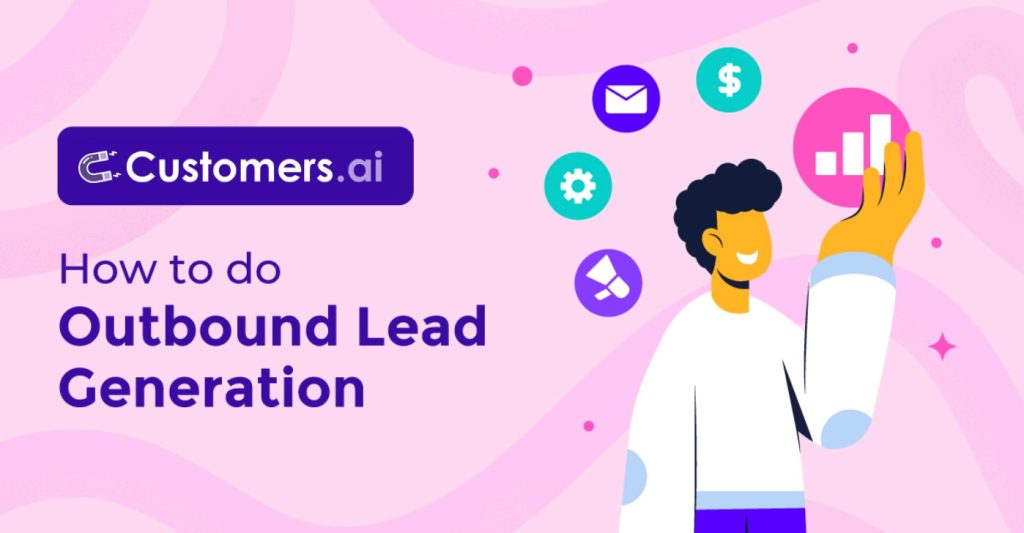Picture this; Your marketing team has been working tirelessly to drive leads. However, none of your sales reps have the capacity to qualify leads or confirm if they’re ready to buy.
On top of it, since manual lead nurturing takes time, it could be a while before you realize the full value of your marketing efforts. Now, the C-suite is asking why you aren’t driving sales and the sales team is mad because they have to sift through all of these leads to determine if they are even qualified.
We have a better solution and it starts with automation.
With the right lead generation tools in place, you can automate outbound tactics, freeing up time to focus on the part that matters most: closing the deal.
Curious what you can achieve with automated outbound lead generation strategy? Our customers have already gotten impressive results. In just six months, one customer captured over $1 million in new customer revenue for a 25x return on investment (ROI).
To help get you started on the road to automation, we are going to show you exactly how to make your outbound lead generation strategy work.
- What is Outbound Lead Generation?
- Inbound vs. Outbound Lead Generation
- Key Components of a Successful Outbound Lead Generation Strategy
- Best Practices for Outbound Lead Generation
- How to Automate Outbound Lead Generation: A Step-by-Step Guide
- Outbound Lead Generation FAQs
Convert Website Visitors into Real Contacts!
Identify who is visiting your site with name, email and more. Get 500 contacts for free!
Understanding Outbound Lead Generation
Before we get into the ‘how’ of it all, we have to understand the outbound lead generation landscape. What does it all mean? What are the challenges? And why is it so important for businesses to be successful?
What is Outbound Lead Generation?
Outbound lead generation is the process of connecting with prospects to find out if they’re a good fit for your company’s products and services.
Usually, outbound lead gen involves a few steps. First, you reach out via SMS or email to ask qualifying questions. Then you follow up with high-value resources or a lead magnet.
Along the way, you capture data about your prospects and nurture them through the customer journey. Then you can deliver the qualified leads to your sales team.
But for most businesses, there’s a missing piece in this equation: intent data. Outbound lead generation can be so much more successful when it’s intent-driven.
You can market to prospects much more effectively when you know what they need and how you can help—because your targeted audience is highly correlated to your target customer.
Inbound vs. Outbound Lead Generation: What’s the Difference?
Inbound lead generation requires prospects to find you. Then you can nurture them with marketing tactics like social media or email marketing.
In fact, we think of inbound marketing like trying to catch fish as they swim by you. Even if you’re a skilled fisherman, there’s a limit to the number of fish you can catch. If only a few swim past, you won’t have many opportunities.
In contrast, outbound lead generation is much more tactical. To extend the fishing metaphor, it’s a little like studying the water and identifying where the fish are. Once you find them, you can use your sales process to go where they are and reel them in.
With outbound marketing, you can also scale your efforts as long as you find the right relevance signals. If you know your target customer well, you’ll have tons of opportunities to fine-tune and leverage those signals.
How Do You Generate Outbound Leads?
To generate outbound leads, you typically need outbound sales outreach. But more often than not, we find that this critical part of the sales funnel is broken.
Outbound sales often require time-consuming tasks like cold calling and lead qualification. Sales teams that manage this process manually may never truly have the time to pursue the most promising leads.
That’s why we recommend a unicorn solution for outbound lead gen. Customers.ai automates repetitive tasks like lead nurturing and qualification so you have time to find decision-makers and close deals.
AI-Powered Advertising
How to Unlock AI and Lead Capture Tech for 10X Return on Ad Spend


HOSTED BY
Larry Kim
Founder and CEO, Customers.ai
Key Components of a Successful Outbound Lead Generation Strategy
Creating a successful outbound lead generation strategy is no easy feat. It takes time, planning, testing, and patience. It also requires a few key components:
1. Target Audience Identification
In outbound lead generation, the key to success lies in identifying and comprehending your target audience.
This involves recognizing your audience, understanding their unique needs, and delivering tailored solutions. By doing so, you ensure that your efforts are directed towards prospects with a higher likelihood of conversion, optimizing resources and crafting outreach that resonates with genuine interest in your products or services.
Not sure where to get started? Start by creating buyer personas for effective targeting:
- Conduct Customer Surveys: Reach out to your existing customer base to gather insights into their preferences, challenges, and motivations. Use surveys to collect quantitative and qualitative data that informs the creation of buyer personas.
- Analyze Customer Data: Leverage data analytics tools to analyze customer behavior, purchase history, and engagement patterns. This data can provide valuable insights into the characteristics and preferences of your target audience.
- Interview Sales and Customer Support Teams: Your frontline teams often have firsthand knowledge of customer pain points and objections. Interviewing sales and customer support teams can offer qualitative insights that complement quantitative data.
- Social Media Listening: Monitor social media platforms to understand the conversations and sentiments of your target audience. Identify the topics they engage with, the influencers they follow, and the trends that resonate with them.
- Competitor Analysis: Analyze the customer base of your competitors. Understand why customers choose them over others and identify gaps or opportunities where your products or services can excel.
These personas, encompassing both demographic and psychographic information, become invaluable guides in tailoring your outbound lead generation efforts for maximum impact.
2. Data Quality and Management
In outbound lead generation, data quality and management cannot be overstated. The integrity of your data serves as a linchpin for success, influencing the effectiveness of your campaigns.
Ensuring data reliability prevents misdirected efforts, resource waste, and missed opportunities. Concrete data quality and management practices are indispensable for precisely targeting prospects, delivering resonant messages, and maintaining the credibility of outreach efforts.
Here are a few tips on maintaining and updating contact databases:
- Regular Audits: Conduct routine audits of your contact databases to identify and rectify inaccuracies, duplications, or outdated information.
- Data Validation Tools: Implement data validation tools to automatically check and update contact information in real-time, reducing the risk of errors.
- User Input Verification: When collecting data, ensure that user inputs are validated in real-time to prevent the entry of incorrect or incomplete information.
- Integration with CRM Systems: Integrate your lead generation efforts with Customer Relationship Management (CRM) systems to facilitate seamless updates and maintain a centralized repository of accurate data.
By prioritizing data quality and implementing proactive management practices, you can enhance the precision of your outbound lead generation efforts.
3. Personalized Outreach
In outbound lead generation, personalized outreach elevates the effectiveness of campaigns by establishing meaningful connections with prospects. Generic approaches should be thrown out the window. Personalized communication is how you capture attention, foster relevance, and increase engagement.
By tailoring messaging to individual needs, interests, and pain points, personalized communication transforms the lead generation process into a relationship-building endeavor, enhancing the likelihood of conversion through a compelling and resonant experience.
Here are a few examples of effective personalized outreach strategies:
- Customized Email Campaigns: Craft email campaigns that address recipients by name, reference their specific industry challenges, and offer tailored solutions. Utilize dynamic content to ensure that each recipient receives content relevant to their needs.
- Segmented Marketing Content: Create diverse content segments targeting different buyer personas or stages of the buyer’s journey. This ensures that your outreach is tailored to the specific interests and concerns of various segments within your audience.
- Personalized Direct Mail: Leverage personalized direct mail campaigns that go beyond generic messages. Include personalized elements such as the recipient’s name, specific pain points, or even customized offers based on their preferences.
- Dynamic Landing Pages: Design landing pages that dynamically adjust content based on the visitor’s characteristics or behavior. This ensures that the information presented aligns with the prospect’s interests and motivations.
By incorporating these personalized outreach strategies, you can improve outbound lead generation efforts by creating a more impactful and personalized experience for potential customers.
4. Multi-Channel Approach
A multi-channel approach allows you to strategically target prospects across different mediums, ensuring that outreach resonates across diverse platforms, meeting prospects where they are most active.
By embracing a diverse and integrated strategy, you increase your chances of capturing attention and engaging prospects through their preferred communication channels in the dynamic landscape of outbound lead generation.
Here are a few advantages of combining email, social media, and other channels:
- Wider Reach: Utilizing multiple channels broadens your reach, allowing you to connect with a diverse audience. Email, social media, and other platforms complement each other, ensuring a comprehensive and inclusive approach.
- Enhanced Engagement: Different prospects prefer different communication channels. A Multi-Channel Approach caters to varied preferences, enhancing engagement by delivering messages through the channels most conducive to individual interaction.
- Consistent Messaging: Integrating channels allows for consistent messaging across platforms. Whether a prospect encounters your brand via email, social media, or other channels, the messaging remains cohesive, reinforcing your value proposition.
- Data Enrichment: Leveraging multiple channels provides additional data points for prospect profiling. The insights gathered from different interactions contribute to a more comprehensive understanding of your audience, facilitating personalized and targeted outreach.
A multi-channel approach gives you consistent and holistic engagement with prospects across a variety of mediums.
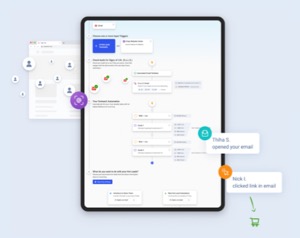
See Who Is On Your Site Right Now!
Turn anonymous visitors into genuine contacts.
Try it Free, No Credit Card Required
Best Practices for Outbound Lead Generation
No guide would be complete without a set of best practices, right? Let’s dig into some key best practices for outbound lead generation.
Focus on Warm Leads
Prioritizing warm leads is a game-changer in outbound lead generation, giving your campaigns a strategic advantage. These leads, already showing interest, are more likely to become customers.
Additionally, warm leads need much less hand-holding and qualification. You may already know what they are interested in, giving you an edge in how to talk to them.
Want to 10x your warm leads list? That’s where Customers.ai comes in. Our Website Visitor ID X-Ray pixel identifies the visitors on your site that you haven’t been able to. It can even let you know what pages they landed on or visited to give you even granular targeting info.
To install the Website Visitor ID X-Ray Pixel, sign up (for FREE!), go to your dashboard, and navigate to My Automations.
Select + New Automation and get your pixel. We have easy install options for Google Tag Manager, WordPress, and Shopify, or you can install the pixel manually.
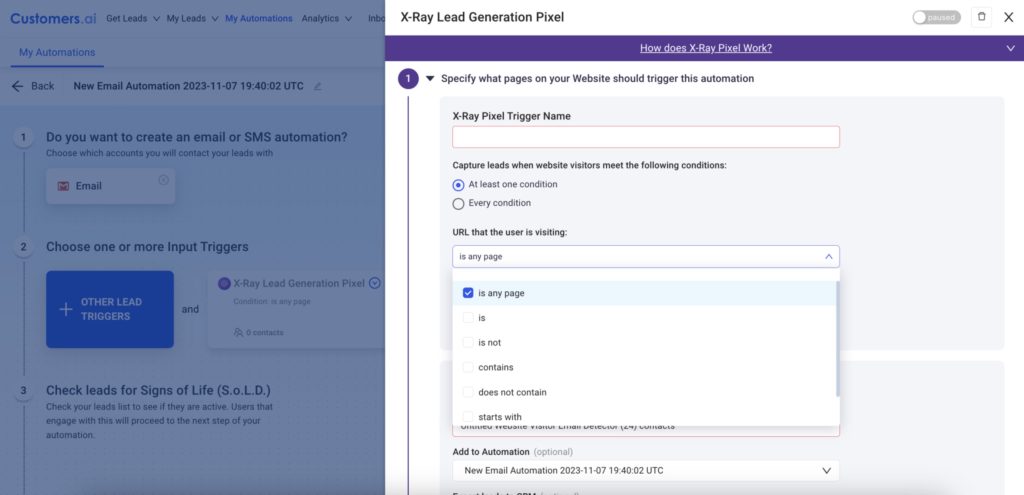
By concentrating on warm leads, you not only make your outreach more efficient but also increase the chances of turning those prospects into loyal customers.
Create Consistent and Compelling Content
Imagine sending out an email series that hits your prospect’s pain points right on the money. Boom! Your open rates skyrocket and you can start initiating conversations that matter. To add a professional touch to your emails, consider incorporating a personalized touch and create HTML email signature. This not only enhances your brand image but also adds a touch of professionalism to every correspondence.
That is all done through creative, consistent, and compelling content. The three C’s. Quality content not only captures attention but also positions your brand as an authoritative resource. Content impacts open rates, drives responses, and creates meaningful interactions with your target audience.
And don’t forget about personalization. Personalization only enhances the effectiveness; a personalized follow-up message referencing a prospect’s industry challenges fosters a deeper connection, increasing the likelihood of conversion.
Add Retargeting to the Mix
Adding retargeting to your outbound lead generation toolkit is a game-changer, tapping into the potential of platforms like Google, LinkedIn and Twitter.
Retargeting extends your outreach beyond initial interactions, allowing you to nurture leads over time and create a lasting brand presence. It’s also a great way to establish that first touch before you send an email.
Integrating retargeting amplifies your impact, with effective strategies like content amplification and targeted ad campaigns ensuring multiple touchpoints with prospects.
With the use of tools like the Customers.ai Website Visitor ID X-Ray pixel, you can expand your reach even further, enriching your retargeting audiences for maximum engagement.
Implement Follow-Up Sequences
Implementing follow-up sequences is a crucial best practice in outbound lead generation, recognizing the vital role of consistent follow-up in nurturing prospects and driving conversions.
This approach acknowledges the complexity of the buyer’s journey, understanding that not every prospect converts with the initial interaction.
By prioritizing consistent follow-up, businesses ensure their brand remains at the forefront of prospects’ minds, guiding them through the decision-making process while also building trust, reinforcing value propositions, and significantly increasing the likelihood of turning leads into loyal customers.
Here are a few tips on creating effective follow-up sequences:
- Segment Your Audience: Tailor follow-up sequences based on audience segments, addressing specific pain points and interests to enhance relevance.
- Diversify Communication Channels: Use a mix of communication channels, including email, phone calls, and social media, to reach prospects where they are most active.
- Provide Value in Each Interaction: Every follow-up should offer value, whether through educational content, personalized offers, or addressing specific concerns raised in previous interactions.
- Set a Consistent Schedule: Establish a regular follow-up schedule to maintain engagement without overwhelming prospects. Consistency builds a sense of predictability and reliability.
- Utilize Automation Tools: Implement automation tools to streamline follow-up sequences, ensuring timely and personalized interactions without manual effort.
- Monitor Prospect Engagement: Keep a close eye on prospect engagement metrics to gauge the effectiveness of your follow-up sequences. Adjust strategies based on response rates and feedback.
- Personalize Follow-Ups: Infuse a personal touch into your follow-up communications, referencing previous interactions and demonstrating a genuine understanding of the prospect’s needs.
By recognizing the importance of multiple touchpoints and providing guidance on creating effective sequences, you can nurture leads effectively and guide them through the conversion journey.
How to Automate Outbound Lead Generation: A Complete Overview
Let’s put outbound marketing to work. Use the tutorial below to automate your B2B lead generation workflow and start filling your sales pipeline.
- Step #1: Know your ideal client
- Step #2: Gather your leads
- Step #3: Create a lead magnet
- Step #4: Set up your outreach
- Step #5: Review, iterate, and test
Outbound Lead Generation Step #1: Know Your Ideal Client
When you seek out potential leads, you want to make sure they’re the right fit for your product or service. Your customer profile is the perfect starting point.
First, define your ideal client. Who uses your company’s products and services? What types of people or organizations get the most value from your offerings?
Then dig into the details. What does your ideal client do? Which problems do they need to solve? What kinds of goals do they want to achieve?
Next, do some competitive research. Your company’s competitors can be a helpful resource for targeting potential customers.
Outbound Lead Generation Step #2: Gather Your Leads
Tap into a data source where you can connect with your ideal customer. In this case, place the Customers.ai Website Visitor ID X-Ray ID pixel on your site. You will immediately capture names, emails, phone numbers, etc. of your website visitors.
Want to expand your list even further? You can use live chat for lead generation, get leads on Facebook, you can use a list of LinkedIn accounts filtered by relevant job titles and groups, or you can even create a list of big (10,000+) Instagram accounts that follow real estate investors.
Need more than that? Check out the Customers.ai Intent-Driven Consumer Directory. Consumer directory is our lead database of over 250,000,000 consumers in the United States. Filter, search, and purchase consumer directory leads and add them to a custom outreach automation to qualify and close leads.
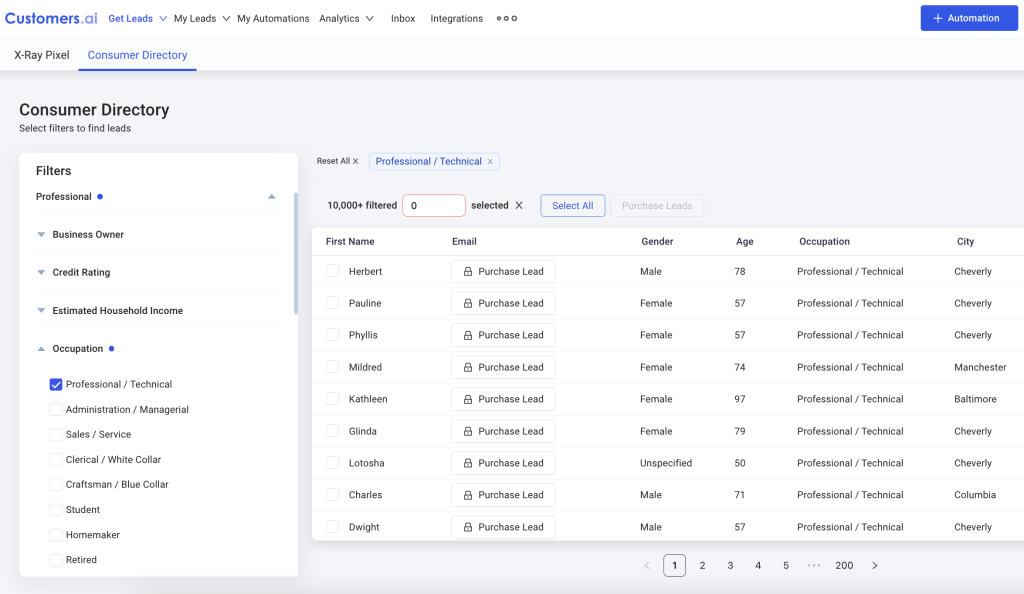
With the ability to search and sort by so many demographics and pyschographics, you can find the people for your outbound lead generation efforts.
Outbound Lead Generation Step #3: Create a Lead Magnet
We’ve found that outbound lead generation strategies work best when we have something valuable to offer prospects. Lead magnets are great for providing value and building trust.
Your lead magnet could be a complete guide to solving one of your audience’s most pressing problems. Or it could be a webinar that offers your audience insider tips. For example:
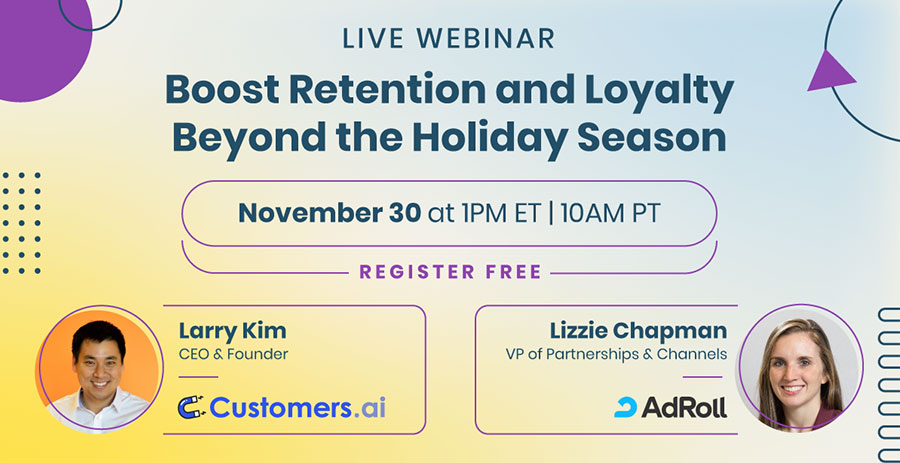
The goal is to keep the communication with the leads going, which is best performed when you have your virtual call center in place.
Outbound Lead Generation Step #4: Set Up Your Outreach
Now you have all the basics in place. Start setting up an automated sequence of email and/or text messages to send to your target audience. Already have sequences set up? Customers.ai integrates with automation tools like Mailchimp and Klaviyo, allowing you to add your leads directly into existing campaigns.
If you are starting a new sequence, consider the following:
- In your first message, start with a super brief introduction and quickly explain why you’re reaching out. Remember to make your message intent-driven.
- Use your customer profile as a guide for crafting your message. For example, you might explain that you help busy business coaches scale faster—which you think might be right up their alley.
- Don’t forget to make your offer compelling and personalize it to them. Check out our AI Email Writer for help.
Having the right outreach is essential to success.
Outbound Lead Generation Step #5: Review, Iterate, and Test
After running your outbound lead generation campaign, go back and review the analytics. Pay attention to message open rate, response rate, and offer conversion rate.
Did a lot of prospects respond Yes but fail to click through and get your lead magnet or book a call? Iterate on your original message to test new copy, personalization, or calls-to-action.
As you test, continue to monitor analytics and keep your eye on the prize. Remember, the ultimate goal is to increase the number of qualified leads for your sales team.
Start Automating Your Outbound Lead Gen
With this automated outbound lead generation strategy, you can simplify your sales process and amplify your B2B marketing.
Want to deliver more leads to your sales team? Get your free Customers.ai trial and start automating outreach.

See Who Is On Your Site Right Now!
Turn anonymous visitors into genuine contacts.
Try it Free, No Credit Card Required
Important Next Steps
- See what targeted outbound marketing is all about. Capture and engage your first 500 website visitor leads with Customers.ai X-Ray website visitor identification for free.
- Talk and learn about sales outreach automation with other growth enthusiasts. Join Customers.ai Island, our Facebook group of 40K marketers and entrepreneurs who are ready to support you.
- Advance your marketing performance with Sales Outreach School, a free tutorial and training area for sales pros and marketers.
Outbound Lead Generation FAQs
Q. Why is outbound lead generation important?
Outbound lead generation allows businesses to take control of their customer acquisition process, reaching out to specific target audiences and generating leads outside of organic channels.
Q. What are the key components of a successful outbound lead generation strategy?
A successful strategy involves identifying target audiences, crafting compelling messages, utilizing various channels, and consistently refining approaches based on performance metrics.
Q. How does outbound lead generation differ from inbound?
Inbound relies on creating content to attract prospects organically, while outbound involves actively reaching out to potential customers through direct communication efforts.
Q. What are common outbound lead generation techniques?
Techniques include cold calling, email campaigns, social media outreach, direct mail, and targeted advertising to engage potential leads.
Q. How can businesses build an effective outbound lead list?
Businesses can build lists by defining their target audience, using data providers, leveraging social media, and attending industry events to identify potential leads.
Q. What role does personalization play in outbound lead generation?
Personalization is crucial in making outreach more relevant and engaging for prospects, increasing the likelihood of a positive response.
Q. How can businesses overcome common challenges in outbound lead generation?
Challenges like rejection and low response rates can be mitigated by refining targeting strategies, improving messaging, and continuously optimizing outreach efforts.
Q. Is outbound lead generation suitable for all types of businesses?
While it can benefit various industries, outbound lead generation is particularly effective for businesses with specific target markets and products/services that require direct engagement.
Q. What metrics should businesses track to measure outbound lead generation success?
Metrics include conversion rates, response rates, lead quality, and the overall return on investment (ROI) of outbound campaigns.
Q. How can businesses enhance their cold calling for lead generation?
Effective cold calling involves thorough research, clear value propositions, active listening, and adapting strategies based on prospect feedback.
Q. What is the role of content in outbound lead generation?
Relevant and valuable content can be used in outbound strategies to educate, inform, and engage prospects, making the brand more memorable and trustworthy.
Q. How can businesses maintain compliance with outbound lead generation regulations?
Staying informed about data protection laws, obtaining consent, and providing opt-out options are essential to ensure compliance with regulations like GDPR and CAN-SPAM.
Q. How does social media contribute to outbound lead generation?
Social media platforms offer opportunities for direct outreach, relationship building, and targeted advertising, making them valuable tools in outbound lead generation.
Q. What is the ideal frequency for outbound email campaigns?
The ideal frequency depends on the target audience and industry. Testing different frequencies and analyzing response rates can help determine the optimal email cadence.
Q. How can businesses create compelling outbound email subject lines?
Compelling subject lines should be concise, relevant, and pique curiosity, encouraging recipients to open and engage with the email content.
Q. What role does follow-up play in outbound lead generation?
Follow-up is crucial for nurturing leads and building relationships. Consistent and timely follow-up can significantly increase conversion rates.
Q. How can businesses leverage technology in outbound lead generation?
Businesses can use CRM systems, marketing automation tools, and analytics platforms to streamline processes, track performance, and optimize outbound campaigns.
Q. How can businesses tailor outbound lead generation for B2B markets?
B2B-focused strategies should involve thorough research, personalized communication, and a deep understanding of the specific needs and challenges faced by businesses.
Q. What is the significance of A/B testing in outbound lead generation?
A/B testing allows businesses to experiment with different elements of their outreach campaigns, helping identify the most effective strategies for improving conversion rates.
Q. How can businesses make their outbound lead generation sustainable?
Sustainability involves continuous improvement, staying updated on industry trends, and adapting strategies based on changing market dynamics and customer preferences.
Q. How can businesses handle objections during outbound lead generation calls?
Handling objections requires active listening, addressing concerns, and emphasizing the value proposition to overcome potential barriers.
Q. What is the role of analytics in optimizing outbound lead generation campaigns?
Analytics provide insights into campaign performance, helping businesses identify areas for improvement, refine targeting, and allocate resources effectively.
Q. How can businesses create a multichannel outbound lead generation strategy?
A multichannel approach involves integrating various communication channels, such as email, social media, and phone calls, to reach prospects through their preferred methods.
Q. What are the best practices for scaling outbound lead generation efforts?
Scaling involves automating repetitive tasks, expanding target audiences strategically, and maintaining a focus on personalization and quality in outreach efforts.
